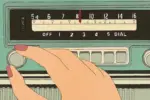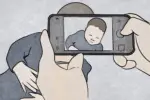Day 12 of quarantine. You wake up after lunchtime and feebly open the blinds to see absolutely no sunlight filtering in through your windows because it’s raining — again. You go get some food from the kitchen, you have to be stingy with the milk though, because the grocery stores are rationing it like it’s wartime. You settle with your cereal on the bed you just got up from.
You’re wearing an oversized hoodie that comprises 1 of 12 old shirts you didn’t take to college because you bought it at a time you weren’t as fashion forward as you are now, but sitting in your bed all day long has caused you to regress into the teen version of yourself you hoped to never meet again. You open up your laptop, and begin scrolling.
Every time your phone goes off, it’s another doom-and-gloom BBC notification that threatens to send you on a coronavirus news rabbit hole, and all your social media feeds are filled with online creators talking about being stuck at home. You continue scrolling.
Sound familiar? Same. Over the past few weeks, the world has gone from bad to worse to “oh my god everyone’s going to die” faster than many world leaders could react. Although there is a non-negligible amount of good news, it’s easy to feel like things are consistently, or perhaps exponentially, degrading. In the midst of this rapidly evolving situation — to appropriate the language of my school’s provost — it’s hard to come up with any semblance of a daily routine.
On campus, no matter which college, there are always things happening. The sheer momentum of campus life keeps you from being bored. Not so at home. We can’t see our friends for fear that someone brought the illness home with them from the airport, we can’t go hang out or work in coffee shops or libraries, we can’t go grocery shopping for fear of the very warranted death glare that cashiers will give anyone who appears to be hoarding and we can’t even really go outside. So, what do we do?
Of course, scrolling for hours in your oversized hoodie is a surefire way to fill time — and for many of us that just got done with sets of exams, a way to take a well-earned break. But that gets old fast, and when the typical ways of filling time like going to the movies and hanging out with friends are blocked from us, we find that we suddenly have great chasms of languishing minutes that crave to be filled with something that doesn’t make you feel like an unproductive slob. Here’s where YouTube comes in.
Likely a website you’re scrolling through anyway, YouTube has as of late become populated by videos on how to deal with the global crisis when you’re stuck at home. Online creators, especially those living in big American cities where the virus has hit hardest, are putting up a steady stream of content informing their viewers how they’ve been attempting to continue their normal lives under quarantine.
For many, quarantine has already become the new norm; one popular search on YouTube is for ”quarantine day in the life,” which pulls up dozens of videos from creators who have already downsized their lives to fit within four walls. Acknowledging their deep gratitude that their biggest problem right now is being a little bored, these creators are taking charge of compiling dozens of ways to get themselves and their viewers moving again. And each of them has something to share that makes this whole situation a little more bearable.
Creator Maya Lee uploaded a video in which she shares some oft-echoed tips to deal with being indoors all day: Drink water, exercise however much you can and use the spare time you didn’t realize you’d have for “edifying and growing” yourself. Her video is practical and relevant, especially when she gives instructions concerning making your own plant-based milk, a skill that wouldn’t go amiss considering current grocery store shortages.
Another creator, oh no nina, repeats similar ideas in her video — make art for fun, cook something new, clean your space (or even redecorate), learn a new skill, catch up on work … the list goes on. For creative people, this anxious time can be used to make things that made us happy instead of attempting to focus diligently on long-term projects.
Nina makes sure to emphasize that for some of us, this might not be the best time to be productive. This isn’t a holiday — this isn’t even a break many of us wanted. Staying at home is necessitated by the uncertainty clouding the world, and if you’re not in the head space to learn a new language or be creative, that’s okay.
But as the world — and our universities — moves online, the call to resume work is resounding for students across the country. So, then we come to the question of how to be productive (as productive as we are on campus) at home. YouTuber creators tackle this on the daily — being self-employed while publishing content that is almost exclusively web-based means that these creators can bring innovative, subtle ideas to the field that can help college students stuck in their high school bedrooms get work done.
For creators that have recently published videos focused more on maintaining high, sustainable levels of productivity, it seems that small tweaks to our physical space can trigger changes in our mental states.
The single most important piece of advice in this vein is implementing some sort of separation between your workspace and your living space. When you work from home, you run the risk of conflating your work mindset with your relaxation mindset. This sends mixed messages to your brain: Are you supposed to be productive on your bed, or are you supposed to relax? Our brains have strong associations with physical places and maintaining that separation between the place you go to work and the place you go to relax is incredibly beneficial.
According to a video from Mariana’s Study Corner, setting up a workstation at the beginning of each day and dismantling it in the evening “creates [the] illusion that there’s a limit between your working hours and your free time.” Essentially, this means designating a part of your room or your house as a makeshift workplace so that your brain builds up associations of focus and productivity for that physical space — neither of which your brain associates with your bed.
There are other aspects to your environment that are conducive to productive work-from-home days, particularly putting on real clothes. According to Ashley from bestdressed on YouTube: “There is something about being in clothes that are slightly uncomfortable that makes you work harder.”
When you work from home, it’s easy to not do your makeup or change out of your pajamas because you’re not going to see anybody, but it’s not about that. Getting fully ready in the morning regardless of whether you’re going to see people is about being presentable to yourself. Your brain knows to get to work when your body is ready and professional, not when you’re still in that old hoodie with unbrushed hair.
And once your physical environment is clear and conducive to productivity, you can tackle decluttering your digital world. Obliged as we are to transfer our whole lives online for the next few months at least, it would behoove us to make sure our online spaces are as clear as our physical ones.
Slumps in productivity will hit, especially when you’re at home and not at a library surrounded by dozens of other diligent students. Breaks are absolutely necessary for making sure you don’t fall into a rut. In Ashley’s video, she says that for her, breaks involve “doing something physical as opposed to something mental.”
These are things like cooking, doing laundry or taking a short walk outside if it’s safe to do so. But taking breaks doesn’t necessarily mean that you’ll experience an immediate uptick in productivity; right now is a time of extreme anxiety for many of us and choosing to care for our mental health takes precedence over getting perfect GPAs or learning a new skill.
Information overload and global confusion in this time can mean a serious increase in anxiety and stress levels. Sometimes it feels like there’s no escape from worsening headlines that cover the tanking economy, global panic-buying, xenophobia and confusing government responses, as well as the ever-pervading question: When will this end?
Being productive and filling time is great and will only help propel you further, but right now, if all you can do is get through the day, that’s enough. Knowing when to shut off the news and giving yourself a break can save our mental states as they spiral towards panic. Aileen at Lavendaire hits the nail on the head in her video regarding maintaining mental health where she emphasizes the importance of knowing how to calm yourself and preserving hope. All of these content creators and many more are dedicated to helping us understand that this, too, shall pass.

















